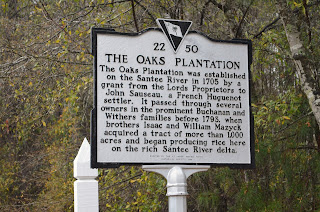This beautiful plantation is directly off US17. During the tour I learn that the highway department took some of the plantation property to build US17. The current owner, Mr. Beatty, a lawyer by profession, had the land put into a conservation trust so that can never happen again. He and his wife believe in the history of the property and very generously open the house to the public for tours. He is also adding to the property. He originally bought the plantation with 70 acres and now owns 120. Mr. Beatty is originally from Columbia SC and his wife is from Aiken.
The entrance is absolutely breathtaking and we are so excited to see the plantation house. The moss adds ambiance and we immediately feel like we are stepping back in time.The historic marker reads: HOPSEWEE Thomas Lynch Jr.. signer of the Declaration of Independence was born here Aug 5, 1749. He was elected from St. Jame's Parish, Santee, to 1st Provincial Congress December 19, 1774, to 2nd Provincial Congress Aug 7-8, 1775, to the Continental Congress March 23, 1776; Commissioned Captain , Provincial troops, June 17, 1775. Served on Committee to draft Constitution for South Carolina 1776. He was lost at sea 1779.
The drive in is beautiful and on unpaved roads. We can imagine horse drawn carriages driving along this same road.
After driving along a dirt and gravel road this is what we see. How spectacular.
We park the car and walk to the Tea Room to book our tour. It's cold and wet but we don't mind. It's beautiful here and we hope we aren't too late to join the 1:00 tour.
My daughter has never seen moss before and cannot resist a touch before we continue.
This is the Tea Room, a building added to the property after the Beatty's purchased the plantation. It's beautiful and fits right in.The front part of the Tea Room is a TV room with a video on a loop about plantation life in the 1700s and about Thomas Lynch and his family. We are a little late but happy that we didn't missed the tour.
After the video, we walk to the house. We use the back entrance.
The back porch side of the house faces a river, not sure which waterway it is though. At one time, this was a large rice growing plantation.
This is the view from the front porch. We enter the house and I am asked not to take photos. The owners don't want anyone knowing what valuables may be inside the house because of robbery potential.
We are upstairs on the porch. We are once again allowed to take photos.
View from the balcony.
Another view on the upstairs balcony.
The step for the ladies of the house to board the carriages.
Side view of the house. We walk to the two existing slave quarters. At one time there were many slave cabins and they were called Slave row. Descendants of the former slaves occupied the cabins until the family either moved away or all the members died. The small cabins on Slave Row became dilapidated and fell apart in ruin. The two remaining slave quarters were used by the kitchen staff and one was occupied as late as the mid 1900s.According to the docent, rice plantations were run by the task system and each slave was given a task to complete according to his age and ability. If he completed the task, he got the rest of the afternoon or evening to do with what he wanted. If he completed two days worth of tasks, then he had the next day off. But if he didn't complete the task he might be punished. They were also encouraged to have families and were not separated and sold.
At one time, Georgetown produced more rice than any country in the world except India. The reason they were so successful is because of the ingenuity of the slaves working here. They had previously lived in areas that grew rice using the same cultivation method needed here and they created and built the rice fields.
Both cabins look alike and are next to each other.
This is the view as you enter the cabin.
This is the other side of the cabin. It is pretty small.
We walk back to the Tea Room for lunch. You can see the other slave cabin in the distance. Beyond that is the Tea Room.
My daughter is very excited to have a special tea time. She loves all the fancy dinnerware around her.
She loves every bit of her special adventure at Hopsewee Plantation.
A small drive down the road, heading back towards Myrtle Beach we found this sign. The plantation owners are growing rice again but they have closed the property off from the public.
The view on the road as I was trying to find another way to see the rice plantation but no such luck. If you are ever in the area, Hopsewee Plantation is definitely worth a visit. The plantation house has most of it's original structures and you get a real feel for life back in the 1700s.































No comments:
Post a Comment